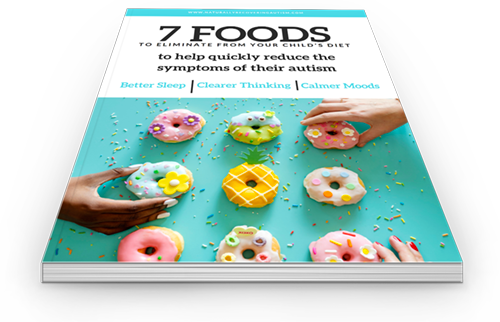Gluten and the Gut Brain Connection
 Does diet really matter? Yes, the intake of gluten can directly affect the brain and the behavior of your child on the autism spectrum.
Does diet really matter? Yes, the intake of gluten can directly affect the brain and the behavior of your child on the autism spectrum.
Gastrointestinal surgeon, Dr. Andrew Wakefield, found the greatest results in treating children with autism came from a gluten free/casein free diet. When he treated the inflammatory bowel disease he found their behavior improved, sleep improved and there was an increase in communication.
Due to bio-engineering of crops and the increased need for gluten as a binder in the ever growing demand for processed food, gluten is no longer the same product it used to be. Our bodies do not even know what to make of it anymore. The substance is seen as a foreign invader which triggers the immune system to react by sending out antibodies to fight the invader. The end result is a cascade of inflammation and the release of dangerous chemicals called cytokines. Cytokines destroy brain cells and leave the brain far more vulnerable to future attack by other foods, inflammation, and any environmental toxin. Children on the autism spectrum are exceptionally vulnerable to the dangers of gluten.
 Gluten (wheat protein) and casein (dairy protein) release natural opiate-like substances into the bloodstream, which, if they get through the blood-brain barrier, can mimic the effects of morphine in the brain. The opiates in casein and gluten are called exorphins, specifically, gluteomorphins and caseomorphins. Their presence causes the same type of reaction in our children as the drug morphine might. That “spacey” look comes from the drug, along with the inability to focus. It is also one of the reasons why people who eat gluten will crave it, in a similar way that a drug addict craves the drug during withdrawal. Gluten, sadly, is capable of crossing the protective blood brain barrier rendering the brain helpless to its effects. Behavioral issues such as hyperactivity and mood disorders are common in people with gluten sensitivity.
Gluten (wheat protein) and casein (dairy protein) release natural opiate-like substances into the bloodstream, which, if they get through the blood-brain barrier, can mimic the effects of morphine in the brain. The opiates in casein and gluten are called exorphins, specifically, gluteomorphins and caseomorphins. Their presence causes the same type of reaction in our children as the drug morphine might. That “spacey” look comes from the drug, along with the inability to focus. It is also one of the reasons why people who eat gluten will crave it, in a similar way that a drug addict craves the drug during withdrawal. Gluten, sadly, is capable of crossing the protective blood brain barrier rendering the brain helpless to its effects. Behavioral issues such as hyperactivity and mood disorders are common in people with gluten sensitivity.
Glyphosate
Glyphosate is a chemical found in the weed killer known as Round-up. It is also sprayed on food crops to dry them out when ready to harvest. We then ingest these extremely harmful chemicals. Wheat crops are heavily sprayed with glyphosate. This chemical damages the gut lining, is known to cause non-Hodgkins lymphoma, and so much more. Please listen to my in-depth podcast interview with Dr. Stephanie Seneff on Glyphosate and Autism.
Leaky Gut
When gluten enters the digestive tract, the immune system reacts by sending out attack cells to fight what it recognizes as a foreign substance. The result from this interaction is a damaged gut lining, also known as “leaky gut”. This damage in the lining of the intestines allows foods passing through to be released, undigested, into the blood stream. There, they create an allergic reaction causing more inflammation in many organs, including the brain. This is also the basis for autoimmune disease. Gluten, by reducing the immune system’s ability to fight, creates reduced levels of glutathione, the body’s master antioxidant, as well as vitamins C, E, and other antioxidants.
Damage to the DNA
The body kicks in a high number of antibodies to fight what it sees as foreign proteins (gluten). This is when those nasty genes are turned on. When the protein, gluten, combines with these antibodies, it triggers genes (DNA) and turns them into bad genes. This changing of genes by environmental factors or trauma is called epigenetics. Now new mutated genes are in the system wreaking havoc and are in the genetic make-up to be passed onto future offspring.
This is commonly seen in people with autism. These issues of neurological imbalance can occur without any sign of digestive disturbance. In fact, it is estimated that 99 percent of people adversely affected by gluten sensitivity are not even aware of it. As much as 30 percent of the Western population may have gluten sensitivity. Many have no signs of digestive disturbance at all, but the nervous system is still being attacked.
Some symptoms of gluten sensitivity
- Epilepsy
- Headache
- Stomach ache
- Skin rashes
- Eczema
- Anxiety
- Depression
- Hyperactivity
- Muscle and motor control issues
- Vertigo
- Neurological problems such as cognitive decline
- Lack of focus
- Early dementia
- Autism
- ADHD
- Alzheimer’s
- Damage to DNA
- Thyroid disorders are commonly found in those with autoimmune diseases. In one study 14% of those with celiac disease (severe gluten allergies), were also found to have autoimmune thyroid disease, 10.3% with hypothyroid, and 3.7 with hyperthyroid (C.E. Counsell, et al, Celiac Disease and Autoimmune Thyroid Disease, Gut 35:844-846, 2005). Going gluten free can actually help reverse thyroid problems.
- Gluten allergies are commonly related to Type 1 diabetes.
- Lyme disease causes sensitivities to gluten.
- Mold Biotoxins create an intolerance to carbohydrates, gluten, dairy, and sugar.
Always watch for symptoms in your child whenever eating any new food or after eating out.
Gluten-containing grains and starches
- Wheat
- Wheat germ
- Barley
- Rye
- Spelt
- Kamut
- Bulgur
- Couscous
- Farina
- Semolina
Gluten-free grains
- Quinoa
- Rice
- Tapioca
- Potato
- Teff
- Millet
- Corn
- Amaranth
- Arrowroot
- Buckwheat
Note: Although these grains are gluten-free, they will still cause a spike in insulin or blood sugar levels that can lead to inflammation. Further, the carbohydrates also turn to sugar in the body, feeding candida/yeast organisms. It is best to minimize grains altogether. See more in my blog post on Mold Biotoxins. Also see my post on Gluten Free Resources. Your safest options are coconut flour and almond flour. The ratio of these is 1:1 as a substitute for wheat flour in any recipe.
Read Your Labels
Gluten is in cereals, cold cut meats, energy bars, cakes, cookies, crackers, pasta, sauces, gravies, soy sauce, salad dressings, and most refined carbohydrate foods. The spike in insulin or blood glucose levels from eating these foods is yet another trigger for neurological damage, especially if they contain wheat. Wheat bread affects blood sugar levels the same way that table sugar does.
Gluten is a “glue” holding together many processed foods. It is also hidden in many other unsuspecting items. Play-Doh, shampoo, soap, lotions, cosmetics, vitamins, medications, condiments, soy sauce, seasonings, gravies, beans, and beer are among the common culprits. Also beware of ingredients that are “hydrolyzed” or contain maltodextrin.
Beware of cross contamination in restaurant kitchens, and manufacturing facilities. The label should list that the product is made in a facility that also carries wheat. Unless it says “gluten free” then it isn’t guaranteed. Even crops are cross contaminated so we can never be completely sure. For example, if oats do not say “gluten free” on the label, then they are not.
Supplements to Help Digest Gluten
Besides staying away from products and foods that contain gluten there is an enzyme that can help. The enzyme called DPP-IV helps with the breakdown of the proteins gluten and casein. It is in some enzyme products, but not all. Read your labels to find it. I like the product Trienza by Houston Enzymes.
Testing for gluten sensitivity
The body sees a food as an allergy when the immune system gets triggered to release histamine. When there is a true allergy to a food the body will create antibodies toward it. Often a test will have negative results for different reasons. For example, gluten binds to tissue, such as in the colon, so a blood test could easily come up negative, or an antibody for another substance may not show up in that particular blood test. This also does not mean that your child does not have intolerance to that food. For this reason, if you get a negative result on a test, do not assume your child does not have sensitivities to it.
Food intolerances can create the same symptoms as allergies. The best way to know whether or not your child has an allergy is to simply remove the food from their diet for a few weeks and see if you notice a difference in their behavior or in their physiology. Often a difference can be noticed in days or within a week or two, but clearing a substance from the body can take up to three months for symptoms to subside.
Since the symptoms for gluten and casein sensitivities are much like those of histamine, it is best to remove all potential allergens from your child’s diet which will also help to eliminate the candida overgrowth. Get my free guide to the top 7 foods to eliminate from your child’s diet. The guide also explains the harmful “why” you’re doing this for each food.
Note: the change in diet will likely cause the candida to start dying off which is a good thing, but as this happens you will likely notice physical and behavioral issues arise in your child. Transitioning the diet to eliminate the bad foods is a slow process for many, also because of the opiate addiction, so take your time. Additionally, if your child has PANS, then they have obsessive compulsive disorder (OCD) which contributes to picky eating.
Natural Allergy Desensitization is a simple way to test for and remove the allergic reaction your body may be having to gluten. Learn more about Natural Allergy Elimination.
You can find already prepared healthy, gluten free Keto cookies to purchase here.
Get Your Free Food Guide!
Quickly Reduce Your Child’s Symptoms of Autism by Eliminating 7 Foods Most People Consume Daily!
The first crucial step of autism recovery is to begin restoring health to the gut and the immune system.
The health of the gut is directly linked to the health of the brain and therefore to the symptoms of autism. In fact, 80% of the immune system comes from the gut so if the gut is not healthy, then the brain can’t thrive, and the immune system is compromised. It’s a vicious cycle, but thankfully, it’s one that we can put an end to by first eliminating harmful foods.
- Harmful Foods: Identify the foods that worsen autism symptoms and understand the science behind their impact.
- Smart Food Choices: Learn about easy dietary swaps that can significantly enhance sleep, clarity of thought, and emotional well-being.
- Practical Implementation: Get valuable tips on how to implement these dietary changes easily and effectively.
This is for informational purposes only and is not meant to diagnose or treat. Every child’s level of recovery is different. No two people are the same. It is never implied that all children will have the same outcome. Results are all based on individual biology and the work that is done. This process takes time and various steps, effort and resources need to be weighed. Our programs are intended to help you become more knowledgeable and guide you to help bring your child a better quality of life, whatever that may be. We want to help by giving great content, direction and strategies that move you forward. Nothing on this page or any of our websites is a promise or guarantee of results or future outcomes. The results on this page and any of our websites are not typical or promised. In fact, there will be people who purchase this and other programs and never put the work into implementing the strategies taught and therefore will achieve little to no results. Our more detailed earnings disclaimer, privacy policy, and terms and conditions for this program and website can be accessed via the links below. We hold ourselves (and you) to a high standard of integrity. We are cheering you on every step of the way.













Hi Karen does the mindlinx product need to arrive super cold?
plus the capsules are impossible to find do you know why?
can it be mixed in some juice?
Thanks
love your book.